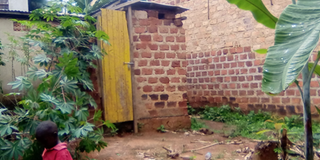Authorities stuck as latrines in Mukono fill up

A child walks past a latrine in Wantoni Village, Mukono District. PHOTO | JESSICA SABANO
What you need to know:
- Dr Anthony Konde, the Mukono municipal medical officer said they are in the process of setting standard designs for toilets, which every developer must follow.
Leaders in Mukono Municipality have decried the declining toilet coverage in the area, which is putting the dwellers at risk of contracting communicable diseases.
According to Mr Erisa Mukasa Nkoyoyo, the Mukono Municipality mayor, 56 percent of pit latrines in the municipality are filled up and some dwellers either practice open defecation or end up sharing with their neighbours.
The mayor said open defecation is rampant in Goma Division along the railway line, which has led to poor sanitation especially when it rains.
“At least 56 percent of pit-latrines in the municipality are filled up and closed. This has forced some residents to opt for open defecation which is dangerous,” he said during an interview on Wednesday
Mr Nkoyoyo also noted that the lavatory facilities in some homes are substandard.
"It's high time we got model toilets and also have an ordinance for those who completely have no toilets.” he added
Dr Anthony Konde, the Mukono municipal medical officer said they are in the process of setting standard designs for toilets, which every developer must follow.
"Mukono is one of the fastest growing urban centers and digging pit latrines is no longer tenable. Developers who plan to use only the traditional pit-latrines on their buildings will be advised to opt for water-borne sanitation facilities before their building plans are approved,” he said.
He said as they work on the ordinance, they are going to enforce the Public Health Act, 2000 which requires every household to have a toilet, dustbins and hand washing facilities.
According to Mr Martin Mugabi Mukasa , a senior environment officer in the Ministry of Water and Environment a recent survey they conducted in Mukono revealed that two per cent of the population have no toilets, 53 per cent share with their neighbours while 20.3 per cent of the toilets have no doors.
“We also found out that these toilets are contaminating the nearby water sources which exposes residents to diseases,” he said.
Mukono Central Division Speaker, Mr Ivan Mawanda urged the central government to help them acquire mobile toilets to address the prevailing open defecation problem within the municipality.
"Mobile toilets can help a lot especially along the Jinja-Kampala like in Namanve area where motorists just park and visit bushes to answer nature’s call, " he said.
Availability of enough lavatory facilities is still a challenge in many developing urban centres and where they exist, the hygienic standards are wanting.
According to Ministry of Health records, 75 percent deaths in Uganda are the result of sanitation –related but preventable diseases, which translates to 300 deaths per day. As a result, the government loses Shs 30 billion on treatment of sanitation and hygiene-related diseases annually alone.




